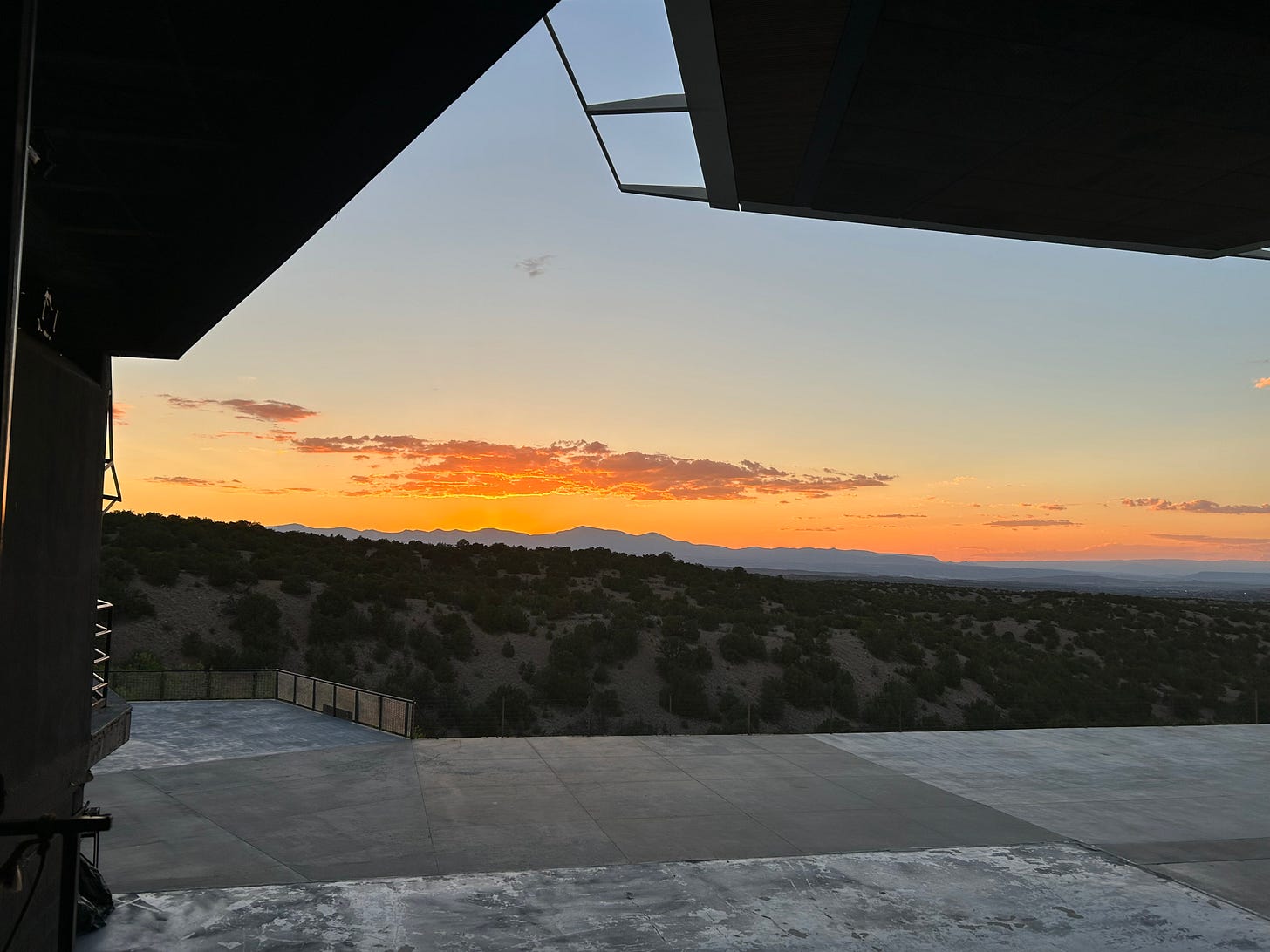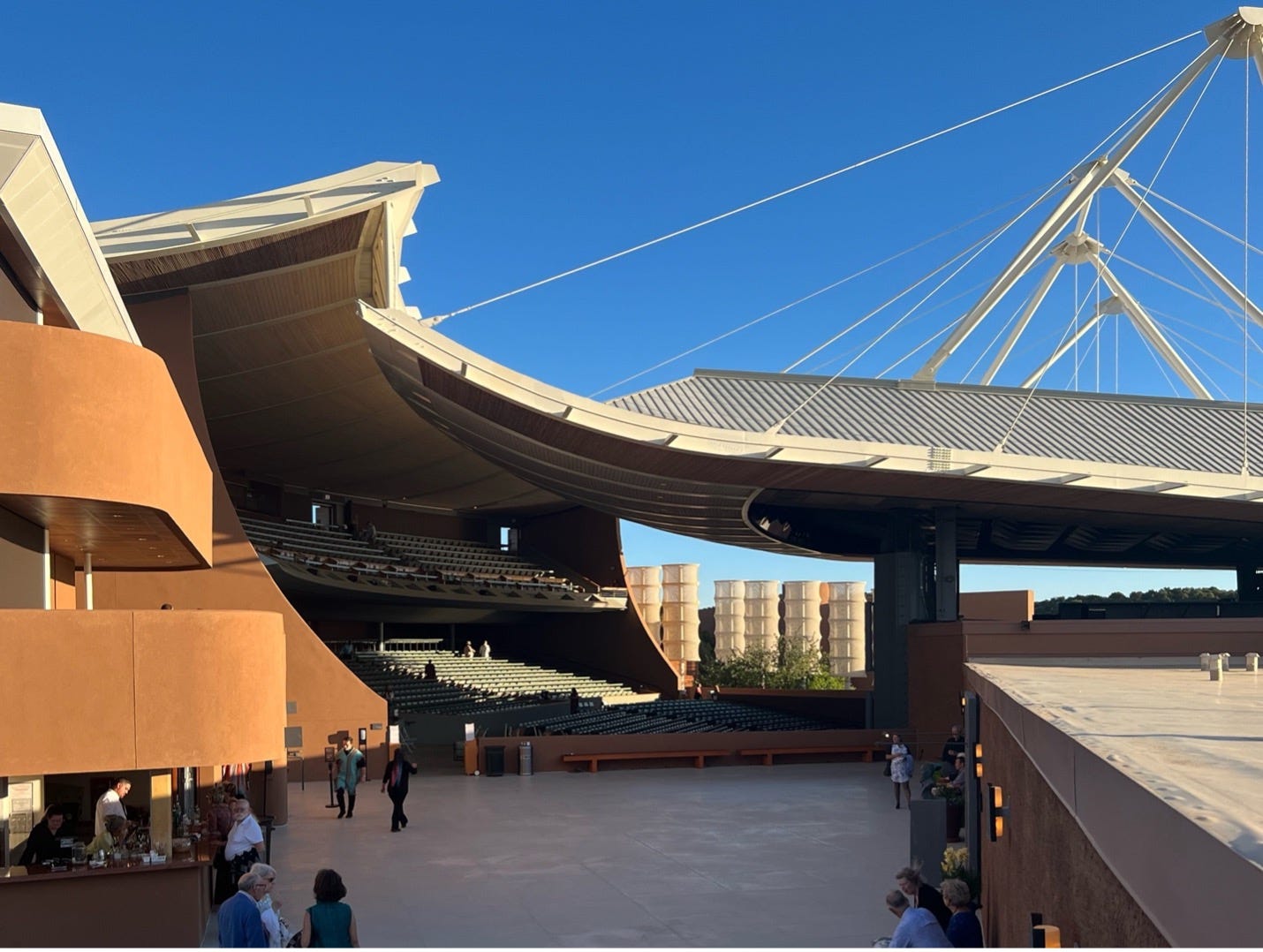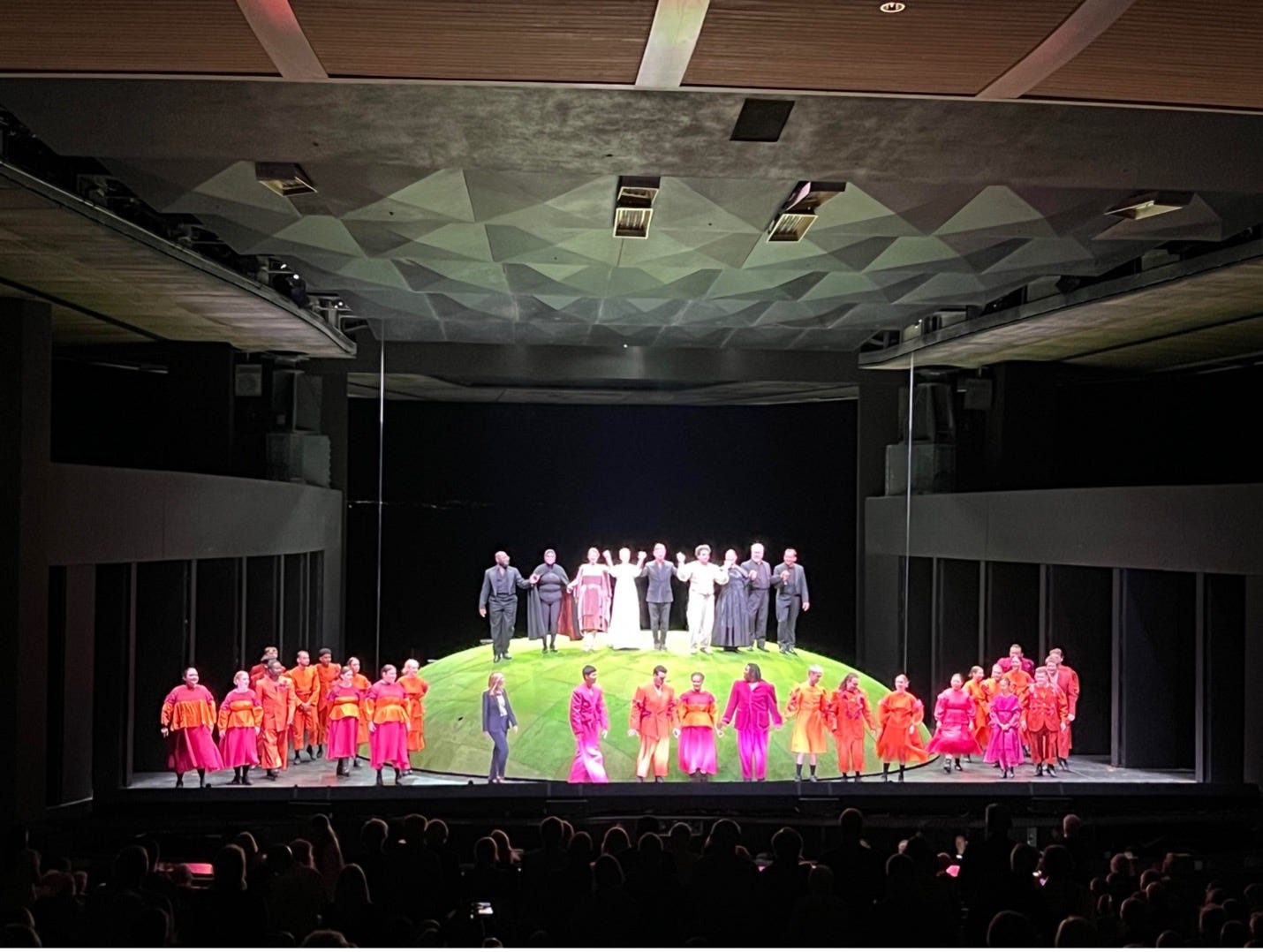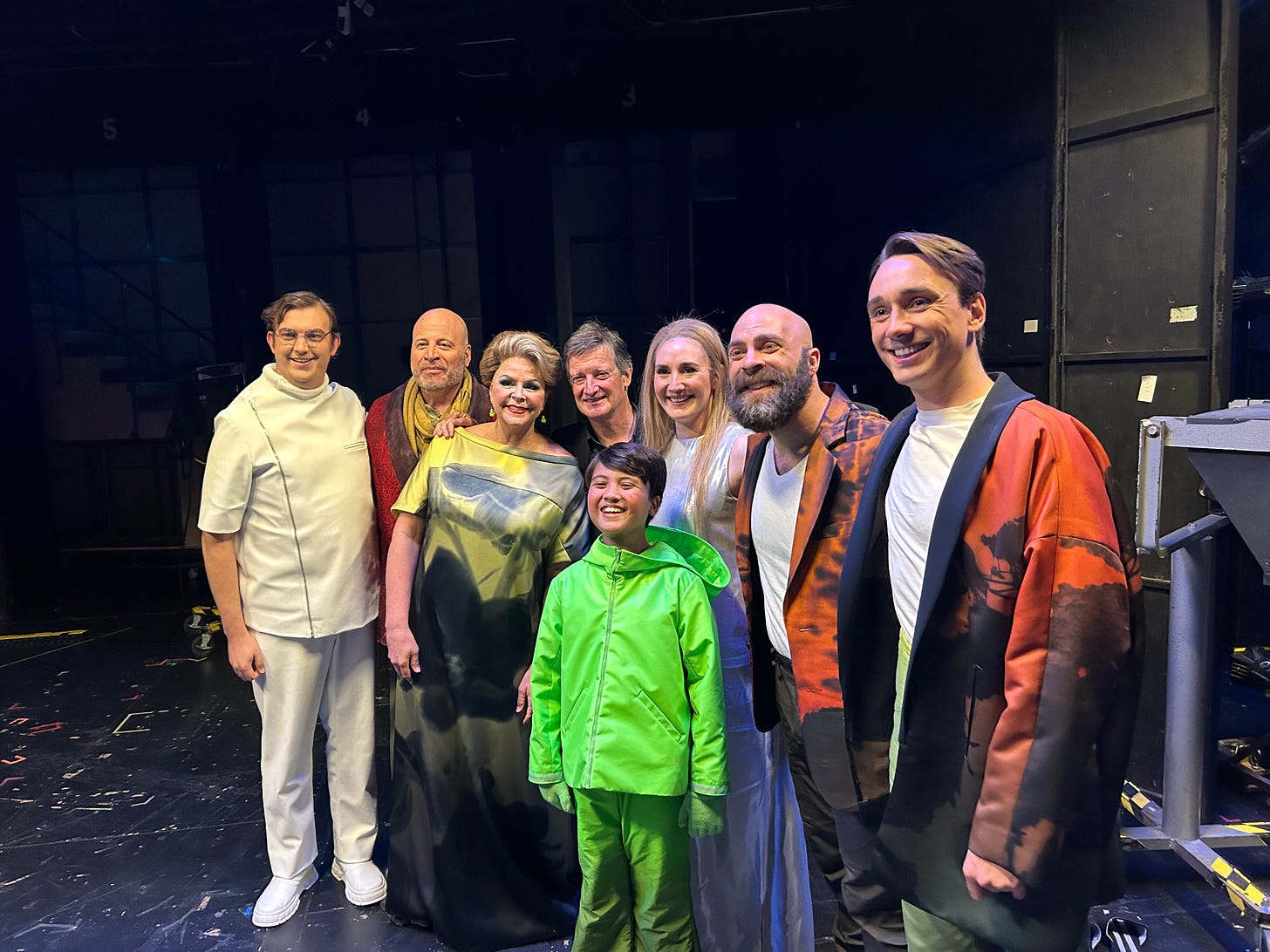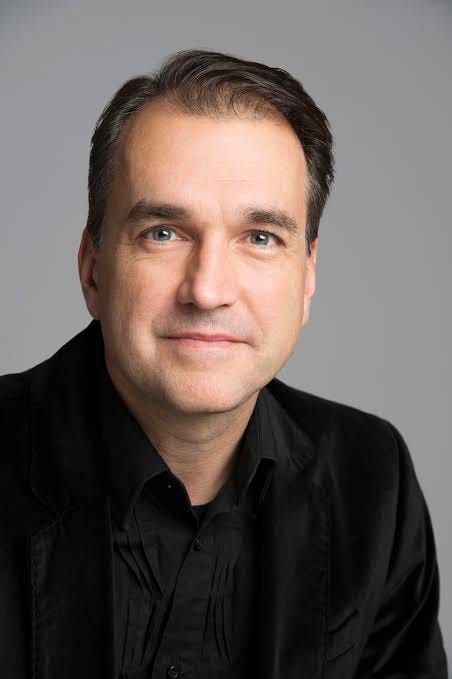Notes from an operatic summer in Santa Fe, New Mexico
We checked in with VO board member Stanis Smith and VO's Head of Music Les Dala on their operatic summers.
Opera and Santa Fe truly go together: Every July and August since 1957, opera lovers have been drawn to the magnificent northern New Mexico mountains to enjoy productions by one of the world’s premier summer opera festivals…
This year VO board member Stanis Smith visited for the first time, and VO’s Head of Music, Les Dala, spent his fifth season at the Santa Fe Opera. Read on to find out more….
A Momentous Trip - reflections and review from Stanis Smith
For many years my wife Joanne and I have dreamt about attending the Santa Fe Opera Season, and this year we were able to make it happen, together with our friends Susan and Bob.
The following are my personal impressions.
The Opera House
It’s hard to imagine a more unlikely location for an outdoor opera house than the small town of Santa Fe, located in a remote corner of North America that is more famous for its UFO sightings than for high culture. The “origin story” of the opera house apparently owes a lot to Stravinsky, who saw its potential, put his name and reputation behind the project, and remained involved with it for several years (his opera, The Rake’s Progress was featured in the very first Santa Fe Opera season in 1957).
The dominant feature of the opera house is an elegant, curved roof suspended by a cable structure anchored to four massive columns. The roof floats dramatically over the raked seating, which is arranged on two tiers, total seat count about 2,100. The audience is covered but not enclosed, able to see the landscape and horizon on either side and (depending on the set design) see behind the stage. Sitting in the hall watching a performance while the sun sets and the sky changes colour around you is an unforgettable experience, and if you are lucky, you may catch the occasional flash of lightning in the distance, or see a bat flying through the hall. We’ve been told that if it rains and you have seats on the side you may get wet, an experience we were spared.
The Operas
Santa Fe produces five operas each year. This season was particularly interesting in that most of the operas, except for Tosca, are somewhat off-the-beaten-track, and all were new productions. My notes below cover the operas in the order that Joanne and I ranked them.
Orfeo
For the record, even though I’ve been involved in performing Baroque music for much of my life, I have to admit that after fifteen minutes or so I yearn for the four-hundred-plus years of musical evolution that has occurred since Monteverdi. For that reason, even though there was a lot of pre-performance fanfare about the score being re-orchestrated by the contemporary composer Nico Muhly, I approached this show with some trepidation.
I need not have been worried, because the production, by Yuval Sharon, was stunning. The stage was filled by a giant enigmatic UFO-like form (possibly a tongue-in-cheek nod to New Mexico’s fondness for UFO’s) and was loosely covered with white fabric that billowed in the wind. Over the course of the opera the form transformed and metamorphosed in various ways, initially becoming a green hill for the joyous “shepherd and nymphs” opening scene. When The Messenger appeared to announce the death of Eurydice, the long train of her black dress was slowly wrapped over the hill like a shroud, and then the whole form lifted off the stage like a giant clamshell to reveal the Underworld, inside of which Orpheus, played by Rolando Villazon, was suspended in front a backdrop of projected images that shimmered like the Northern Lights. At the end of the opera the form returned to its initial state.
It was a brilliant and memorable piece of staging, reminiscent of Robert Lepage in many ways. Muhly’s re-orchestration was sufficiently interesting and varied to keep our attention. Villazon did an excellent job of playing Orpheus with passion and energy, although his voice did not have the ringing quality that built his reputation. Lauren Snouffer was vocally superb in the dual roles of Music and Hope. But the production was the star of the show, and the highlight of the entire season for us.
Rusalka
For Dvorak’s fairy tale, Rusalka this production sets the action inside a bleak psychiatric institution, with occasional flourishes that seem to have been inspired by absurdist theatre, Monty Python and Sweeney Todd. The walls are lined with tall white lockers. The floor slopes to one side as if it’s been through an earthquake. Water fills the lower part of the floor (post-earthquake plumbing leak?). A tree-like structure composed of metal chairs welded together at impossible angles sits in the water. Rusalka, the water nymph, seems to be a patient in this institution, as does the Water Gnome, dressed in a green dressing gown and inexplicably in a wheelchair from time to time. As the opera unfolds, lockers transform into giant glass display cases, occasionally encasing Rusalka and other characters. Jezibaba, the witch, a formidable character in black, prepares Rusalka’s transformation potion (which is required by the rules of Water Nymph-dom for Nymphs to become visible to humans, which in Rusalka’s case means the Prince). An operating table emerges from one of the lockers, on top of which is a severed pig’s head, torso and other disgusting piles of offal and entrails. Jezibaba shoves what appears to be a live cat into the blender, a memorable moment. At the marriage ceremony between Rusalka and the Prince, the Foreign Princess (opposed to the marriage) appears in blazing red outfit riding a gold statue of a stallion. After intermission the display cases appear to have suffered another more severe earthquake, and litter the stage at crazy angles.
You get the picture? All very enjoyable in a crazy way. Great performances from the three lead females, particularly Ailyn Perez as Rusalka, with impassioned and energetic conducting from Lidiya Yankovskaya (Footnote: according to a post-performance conversation with one of the musicians, she has spent a bit too much time “conducting in front of a mirror”, which may or may not be the case, but the orchestral results were impressive).
Pelleas et Melisande
We were looking forward to this rarely-performed Opera with much anticipation, which was only partially satisfied. The score is vintage Debussy, ethereal and evocative. The plot is a classic love-triangle exploring themes of jealousy and forbidden love, expressed through language that is symbolic and oblique. The producer chose to depict all of this using a sparse black set with two spiral staircases on either side of the stage, plus three TV screens that displayed various images such as security-camera footage, and a large glass terrarium that occasionally revolved. At the back of the terrarium three large fans slowly rotated, and inside it was what looked like a large grow-op. Projections on the back wall came and went in various shades of green, sometimes abstract, sometimes with alphanumeric or geometric displays, occasionally intriguing, more frequently impenetrable. Many scenes included onstage ‘doubles’ for reasons that eluded us. Suffice it to say that the first half was a very slow burn.
The second half picked up, with Pelleas (Melisande’s love interest) being satisfyingly murdered by Golaud (his brother-in law, and Melisande’s husband) to music of great intensity, but the death of Melisande was drawn-out and anti-climactic. The singing was uniformly excellent, with Huw Montague Rendall (Pelleas) and Samantha Hankey (Melisande) delivering outstanding performances. The opera’s pacing and symbolism tested our patience, and it is not surprising that it is on the fringe of the standard repertoire.
Tosca
This production of Tosca was directed by Keith Warner, who directed the impenetrable Ring Cycle that we saw in London several years ago. He decided to update the setting to pre-Second-World-War Italy, with a set consisting of unsettling surrealistic colonnades inspired by a famous De Chirico painting. So far, so good, although one could argue that if you are going to update Tosca there are plenty of current police-states to choose from, Putin’s Russia being the most obvious.
We won’t talk about the final bizarre directorial touch, in which our Tosca, contemplating suicide, is mysteriously joined by a second Tosca of Barbie proportions, and both exit the stage in different directions.
A successful performance of Tosca should deliver catharsis and “purge through pity and terror”, to quote Aristotle. This one was an enjoyable if somewhat frustrating evening in a lovely opera house, watching the sun setting behind a three-dimensional De Chirico.
The Flying Dutchman
Dutchman has great music but severe challenges with its plot, notably that the audience needs to suspend disbelief in the opera’s mythic elements (legendary ghost ship, captain doomed by the devil to sail the seas for eternity, setting foot on land every seven years in search of redemption by a faithful woman, etc).
This production ignores the mythic aspects which are admittedly hard to digest these days. Instead, we are treated to a grubby bride-trafficking transaction in which Daland, the captain of a mid-century cargo ship, gets rewarded for selling his daughter Senta to the Dutchman, the captain of another cargo ship. Rusty shipping containers line both sides of the stage. More shipping containers drift across the stage from time to time, with contorted figures silhouetted behind obscure glazed panels (why?). Massive pipes appear onstage to suggest a ship’s engine-room.
In Wagner’s original stage directions there is a scene in which peasant women spin yarn. This production substitutes peasant women with yellow-jacketed mechanics spinning valves. Senta, apparently in charge of accounting, sits to one side working an adding machine. But in her spare time she has been taking art classes, and she carries around a portfolio inside of which is a sketch of her imagined superhero, the Dutchman, drawn in Dick Tracy comic-book style. And so on and so forth through a maze of directorial contortions. The result was bleak, confusing, chaotic, decidedly unmythic and unredemptive.
Setting aside the weaknesses of the production, the young conductor, Thomas Guggeis, was impressive, and the singers were superb. Nicholas Brownlee was powerful and commanding as the Dutchman, Elsa van den Heever delivered Senta’s arias with effortless ease and blazing high notes, Morris Robinson was glorious in the role of Daland (although a bit too “nice”) and Richard Smagur was that rare animal, a convincing Wagnerian tenor.
Postscript
The day after Rusalka we were strolling along the streets of Santa Fe. As we walked past the San Miguel Chapel, supposedly the oldest church in the United States, we heard someone singing an Edith Piaf song, so we wandered in to discover an unlikely trio of Soprano, Harp and Cello wrapping up a rehearsal for a chamber concert later that afternoon. Turned out that the Harpist was the principal player in the orchestra, the cellist was her husband, and the soprano was one of the singers in the opera season. We stayed for the concert, which was a delightful selection of songs from Baroque to present day and after the concert we were then invited to have a slice of pizza with the performers. An unexpected treat!
Architect by day, musician by night, Stanis Smith’s professional career has included leading major architectural firms, with a particular specialty in airport design. His musical career includes being a clarinettist in orchestras and chamber ensembles. He is on the board of Vancouver Opera and the Rick Hansen Foundation, and previously was on the boards of the Vancouver Symphony and Friends of Chamber Music.
Reflections from Les Dala
This season has been my 5th on the Music Staff of the Santa Fe Opera, the first being back in 2008. Santa Fe is a magical place and the Santa Fe Opera is a world class summer festival that attracts the finest singers, conductors, and directors in varied repertoire, always combining warhorses with lesser known works and a premiere of some kind.
This summer I was lucky to work as the Assistant Conductor on a new production of Debussy's Pelleas et Melisande conducted by Music Director, Harry Bicket and conceived and directed by Netia Jones. This is a rarely performed masterpiece and I had actually worked on it exactly 20 years ago in August 2003 when Vancouver Opera presented it in concert as part of Festival Vancouver (later renamed Music Fest Vancouver) conducted by Jonathan Darlington and starring Russell Braun, Nathalie Paulin and the late Gaetan Laperriere. It's a desert island piece for me so it has been a real gift to spend an entire summer working on it and absorbing it.


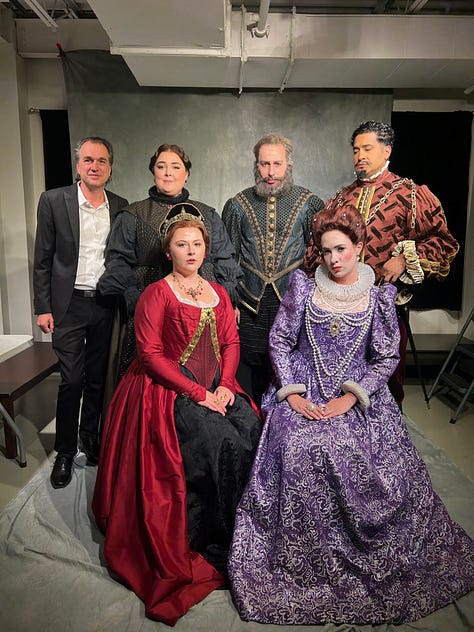
Also, I have been an Assistant Conductor on a new production of Wagner's The Flying Dutchman (which I just conducted for VO back in May!) conceived and directed by David Alden and conducted by Thomas Guggeis who is the new Music Director of the Frankfurt Opera and recently conducted Dutchman at the MET. An interesting connection is the first time I worked on Dutchman was back in 2000 at the Canadian Opera Company as a repetiteur and the director of that production was Christoper Alden (David's brother) and that production was recently revived in the fall of 2022 at the COC. The next time was at VO in our 2001 production. I had not worked on it in over 20 years until the two back to back productions in Vancouver and Santa Fe. If this trend continues I look forward to the next pair of Dutchmans productions sometime in 2045!!!! :)
It's been a great summer working with amazing friends and colleagues but I am very much looking forward to being back in Vancouver soon and catch a short break before jumping into our exciting 2023/24 season!
Les Dala is the Head of Music at Vancouver Opera. Conductor and pianist, Leslie Dala enjoys a multifaceted career spanning the genres of opera, symphonic music, choral and contemporary works. On the podium, he is known for his passionate, dynamic, and charismatic approach to music making





